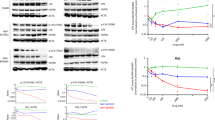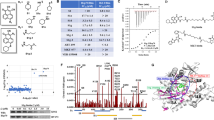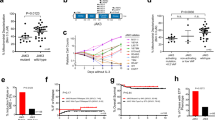Abstract
We previously found that tyrosine kinase 2 (TYK2) signaling through its downstream effector phospho-STAT1 acts to upregulate BCL2, which in turn mediates aberrant survival of T-cell acute lymphoblastic leukemia (T-ALL) cells. Here we show that pharmacologic inhibition of heat shock protein 90 (HSP90) with a small-molecule inhibitor, NVP-AUY922 (AUY922), leads to rapid degradation of TYK2 and apoptosis in T-ALL cells. STAT1 protein levels were not affected by AUY922 treatment, but phospho-STAT1 (Tyr-701) levels rapidly became undetectable, consistent with a block in signaling downstream of TYK2. BCL2 expression was downregulated after AUY922 treatment, and although this effect was necessary for AUY922-induced apoptosis, it was not sufficient because many T-ALL cell lines were resistant to ABT-199, a specific inhibitor of BCL2. Unlike ABT-199, AUY922 also upregulated the proapoptotic proteins BIM and BAD, whose increased expression was required for AUY922-induced apoptosis. Thus, the potent cytotoxicity of AUY922 involves the synergistic combination of BCL2 downregulation coupled with upregulation of the proapoptotic proteins BIM and BAD. This two-pronged assault on the mitochondrial apoptotic machinery identifies HSP90 inhibitors as promising drugs for targeting the TYK2-mediated prosurvival signaling axis in T-ALL cells.
This is a preview of subscription content, access via your institution
Access options
Subscribe to this journal
Receive 12 print issues and online access
$259.00 per year
only $21.58 per issue
Buy this article
- Purchase on Springer Link
- Instant access to full article PDF
Prices may be subject to local taxes which are calculated during checkout







Similar content being viewed by others
References
Goldberg JM, Silverman LB, Levy DE, Dalton VK, Gelber RD, Lehmann L et al. Childhood T-cell acute lymphoblastic leukemia: the Dana-Farber Cancer Institute acute lymphoblastic leukemia consortium experience. J Clin Oncol 2003; 21: 3616–3622.
Marks DI, Paietta EM, Moorman AV, Richards SM, Buck G, DeWald G et al. T-cell acute lymphoblastic leukemia in adults: clinical features, immunophenotype, cytogenetics, and outcome from the large randomized prospective trial (UKALL XII/ECOG 2993). Blood 2009; 114: 5136–5145.
Oudot C, Auclerc MF, Levy V, Porcher R, Piguet C, Perel Y et al. Prognostic factors for leukemic induction failure in children with acute lymphoblastic leukemia and outcome after salvage therapy: the FRALLE 93 study. J Clin Oncol 2008; 26: 1496–1503.
Schrappe M, Hunger SP, Pui CH, Saha V, Gaynon PS, Baruchel A et al. Outcomes after induction failure in childhood acute lymphoblastic leukemia. N Engl J Med 2012; 366: 1371–1381.
Aifantis I, Raetz E, Buonamici S . Molecular pathogenesis of T-cell leukaemia and lymphoma. Nat Rev Immunol 2008; 8: 380–390.
Sanda T, Tyner JW, Gutierrez A, Ngo VN, Glover J, Chang BH et al. TYK2-STAT1-BCL2 pathway dependence in T-cell acute lymphoblastic leukemia. Cancer Discov 2013; 3: 564–577.
Taipale M, Krykbaeva I, Koeva M, Kayatekin C, Westover KD, Karras GI et al. Quantitative analysis of HSP90-client interactions reveals principles of substrate recognition. Cell 2012; 150: 987–1001.
Caldas-Lopes E, Cerchietti L, Ahn JH, Clement CC, Robles AI, Rodina A et al. Hsp90 inhibitor PU-H71, a multimodal inhibitor of malignancy, induces complete responses in triple-negative breast cancer models. Proc Natl Acad Sci USA 2009; 106: 8368–8373.
Wandinger SK, Richter K, Buchner J . The Hsp90 chaperone machinery. J Biol Chem 2008; 283: 18473–18477.
Taipale M, Jarosz DF, Lindquist S . HSP90 at the hub of protein homeostasis: emerging mechanistic insights. Nat Rev Mol Cell Biol 2010; 11: 515–528.
Trepel J, Mollapour M, Giaccone G, Neckers L . Targeting the dynamic HSP90 complex in cancer. Nat Rev Cancer 2010; 10: 537–549.
Isaacs JS, Xu W, Neckers L . Heat shock protein 90 as a molecular target for cancer therapeutics. Cancer Cell 2003; 3: 213–217.
Jhaveri K, Taldone T, Modi S, Chiosis G . Advances in the clinical development of heat shock protein 90 (Hsp90) inhibitors in cancers. Biochim Biophys Acta 2012; 1823: 742–755.
Neckers L, Workman P . Hsp90 molecular chaperone inhibitors: are we there yet? Clin Cancer Res 2012; 18: 64–76.
Marubayashi S, Koppikar P, Taldone T, Abdel-Wahab O, West N, Bhagwat N et al. HSP90 is a therapeutic target in JAK2-dependent myeloproliferative neoplasms in mice and humans. J Clin Invest 2010; 120: 3578–3593.
Weigert O, Lane AA, Bird L, Kopp N, Chapuy B, van Bodegom D et al. Genetic resistance to JAK2 enzymatic inhibitors is overcome by HSP90 inhibition. J Exp Med 2012; 209: 259–273.
Eccles SA, Massey A, Raynaud FI, Sharp SY, Box G, Valenti M et al. NVP-AUY922: a novel heat shock protein 90 inhibitor active against xenograft tumor growth, angiogenesis, and metastasis. Cancer Res 2008; 68: 2850–2860.
Whitesell L, Bagatell R, Falsey R . The stress response: implications for the clinical development of hsp90 inhibitors. Curr Cancer Drug Targets 2003; 3: 349–358.
Mesa RA, Loegering D, Powell HL, Flatten K, Arlander SJ, Dai NT et al. Heat shock protein 90 inhibition sensitizes acute myelogenous leukemia cells to cytarabine. Blood 2005; 106: 318–327.
Anderson NM, Harrold I, Mansour MR, Sanda T, McKeown M, Nagykary N et al. BCL2-specific inhibitor ABT-199 synergizes strongly with cytarabine against the early immature LOUCY cell line but not more-differentiated T-ALL cell lines. Leukemia 2014; 28: 1145–1148.
Ni Chonghaile T, Roderick JE, Glenfield C, Ryan J, Sallan SE, Silverman LB et al. Maturation stage of T-cell acute lymphoblastic leukemia determines BCL-2 versus BCL-XL dependence and sensitivity to ABT-199. Cancer Discov 2014; 4: 1074–1087.
Peirs S, Matthijssens F, Goossens S, Van de Walle I, Ruggero K, de Bock CE et al. ABT-199 mediated inhibition of BCL-2 as a novel therapeutic strategy in T-cell acute lymphoblastic leukemia. Blood 2014; 124: 3738–3747.
Van Vlierberghe P, Ambesi-Impiombato A, Perez-Garcia A, Haydu JE, Rigo I, Hadler M et al. ETV6 mutations in early immature human T cell leukemias. J Exp Med 2011; 208: 2571–2579.
Certo M, Del Gaizo Moore V, Nishino M, Wei G, Korsmeyer S, Armstrong SA et al. Mitochondria primed by death signals determine cellular addiction to antiapoptotic BCL-2 family members. Cancer cell 2006; 9: 351–365.
Chao DT, Linette GP, Boise LH, White LS, Thompson CB, Korsmeyer SJ . Bcl-XL and Bcl-2 repress a common pathway of cell death. J Exp Med 1995; 182: 821–828.
Bonni A, Brunet A, West AE, Datta SR, Takasu MA, Greenberg ME . Cell survival promoted by the Ras-MAPK signaling pathway by transcription-dependent and -independent mechanisms. Science 1999; 286: 1358–1362.
Knoechel B, Roderick JE, Williamson KE, Zhu J, Lohr JG, Cotton MJ et al. An epigenetic mechanism of resistance to targeted therapy in T cell acute lymphoblastic leukemia. Nat Genet 2014; 46: 364–370.
Coustan-Smith E, Mullighan CG, Onciu M, Behm FG, Raimondi SC, Pei D et al. Early T-cell precursor leukaemia: a subtype of very high-risk acute lymphoblastic leukaemia. Lancet Oncol 2009; 10: 147–156.
Bouillet P, Metcalf D, Huang DC, Tarlinton DM, Kay TW, Kontgen F et al. Proapoptotic Bcl-2 relative Bim required for certain apoptotic responses, leukocyte homeostasis, and to preclude autoimmunity. Science 1999; 286: 1735–1738.
Opferman JT, Letai A, Beard C, Sorcinelli MD, Ong CC, Korsmeyer SJ . Development and maintenance of B and T lymphocytes requires antiapoptotic MCL-1. Nature 2003; 426: 671–676.
Reynolds C, Roderick JE, Labelle JL, Bird G, Mathieu R, Bodaar K et al. Repression of BIM mediates survival signaling by MYC and AKT in high-risk T-cell acute lymphoblastic leukemia. Leukemia 2014; 28: 1819–1827.
Paraiso KH, Haarberg HE, Wood E, Rebecca VW, Chen YA, Xiang Y et al. The HSP90 inhibitor XL888 overcomes BRAF inhibitor resistance mediated through diverse mechanisms. Clin Cancer Res 2012; 18: 2502–2514.
Haarberg HE, Paraiso KH, Wood E, Rebecca VW, Sondak VK, Koomen JM et al. Inhibition of Wee1, AKT, and CDK4 underlies the efficacy of the HSP90 inhibitor XL888 in an in vivo model of NRAS-mutant melanoma. Mol Cancer Ther 2013; 12: 901–912.
Sessa C, Shapiro GI, Bhalla KN, Britten C, Jacks KS, Mita M et al. First-in-human phase I dose-escalation study of the HSP90 inhibitor AUY922 in patients with advanced solid tumors. Clin Cancer Res 2013; 19: 3671–3680.
Jensen MR, Schoepfer J, Radimerski T, Massey A, Guy CT, Brueggen J et al. NVP-AUY922: a small molecule HSP90 inhibitor with potent antitumor activity in preclinical breast cancer models. Breast Cancer Res 2008; 10: R33.
Acknowledgements
We thank Dr Anthony Letai for helpful discussions and critical review. We also thank John R Gilbert for critical review of the manuscript and editorial suggestions, and Drs Julia Etchin and Cherry Ng-Dombrowsky for helpful advice and assistance. This research was supported by fellowships and grants from the Leukemia & Lymphoma Society (CDP5014-14; KA), the Lauri Strauss Leukemia Foundation (2013 Discovery research grant; KA) and NPO Corporation the Gold Ribbon Network of the Japan (KA), Bridge grant from Alex’s Lemonade Stand Foundation, and grants from the National Cancer Institute (5R01CA176746 and 5P01CA109901) (ATL). MRM is funded by the Claudia Adams Barr Innovative Basic Science Research Program and the Kay Kendall Leukaemia Trust of the UK. TS is supported by a grant from the National Research Foundation, Prime Minister’s Office, Singapore under its NRF Fellowship Programme (Award No. NRF-NRFF2013-02). DMW is supported by a Translational Research Program award from the Leukemia & Lymphoma Society. We also thank Novartis for the compound NVP-AUY922.
Author information
Authors and Affiliations
Corresponding author
Ethics declarations
Competing interests
Dr Radimerski is an employee of Novartis. Dr Weinstock receives research funding and is a consultant for Novartis. The remaining authors declare no conflict of interest.
Additional information
Supplementary Information accompanies this paper on the Leukemia website
Rights and permissions
About this article
Cite this article
Akahane, K., Sanda, T., Mansour, M. et al. HSP90 inhibition leads to degradation of the TYK2 kinase and apoptotic cell death in T-cell acute lymphoblastic leukemia. Leukemia 30, 219–228 (2016). https://doi.org/10.1038/leu.2015.222
Received:
Revised:
Accepted:
Published:
Issue Date:
DOI: https://doi.org/10.1038/leu.2015.222
This article is cited by
-
Exploring the oncogenic and therapeutic target potential of the MYB-TYK2 fusion gene in B-cell acute lymphoblastic leukemia
Cancer Gene Therapy (2022)
-
AUY922 induces retinal toxicity through attenuating TRPM1
Journal of Biomedical Science (2021)
-
HSP90 inhibitor NVP-BEP800 affects stability of SRC kinases and growth of T-cell and B-cell acute lymphoblastic leukemias
Blood Cancer Journal (2021)
-
Molecular chaperone Hsp90 protects KCBP from degradation by proteasome in Dunaliella salina cells
Folia Microbiologica (2021)
-
Targeting nuclear β-catenin as therapy for post-myeloproliferative neoplasm secondary AML
Leukemia (2019)



